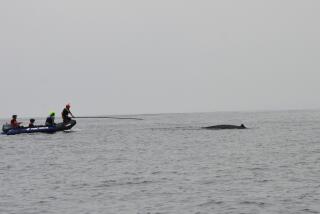Whale Watch Gives Birth to a New Theory
SACRAMENTO — Is Humphrey pregnant?
Should the 40-ton humpback whale really be called Humphreyetta?
Is the celebrated animal planning to give birth in the Sacramento River?
Those were some of the questions that surfaced Wednesday as scientists prepared to meet today in the hope of devising a new strategy to help the whale back to salt water.
The pregnancy theory is one of more than half a dozen hypotheses advanced by scientists and whale-watchers to explain the 40-foot animal’s unusual decision to swim into the San Francisco Bay and up the Sacramento.
But so far, it has been given little weight by the experts, who continue to believe that the 40-foot whale is a male.
“I don’t put any credence in that theory,” said Jim Lecky, a wildlife biologist with the National Marine Fisheries Service and a leader in the operation to rescue the whale. “I think he’s just lost.”
Lecky and other biologists who have tried to help Humphrey, as the whale has become known, emphasize that no one really knows why the whale decided to swim across California when others of its kind are on their way to Hawaii.
Pilgrimage up River
The whale passed under Golden Gate Bridge three weeks ago and proceeded in subsequent days up the river to a shallow, dead-end slough more than 60 miles from the Pacific Ocean.
A fleet of rescue boats drove the animal out of the slough and down the river past Pittsburg--a total of 27 miles over three days. But the operation was called off when the whale swam back upstream about 12 miles to Decker Island, where it has been swimming back and forth since Monday.
Rescuers have been operating on the assumption that the whale is lost and needs help in finding its way back to the ocean.
As it swims downstream, it is frequently disoriented by such man-made devices as power lines that emit a low-frequency signal and by bridges that seem to block its path.
The idea that the animal is pregnant was advanced Wednesday by a state official who suggested that the whale is going to give birth because it seems to be carving out its own territory in a small stretch of the river near Decker Island.
“We’re saying this is another possibility to add to the pot,” said Bev Passorello, legislative liaison with the state Office of Emergency Services, who has been active in the rescue attempt.
Humpback researcher Debbie Ferrari said it is possible, but highly unlikely, that the whale is pregnant. Biologists have found no evidence to indicate that the whale is about to give birth, she said.
Humphrey is probably a male because it has white scars behind its dorsal fin typical of those that result when males fight during the breeding season, she said. Only about 20% of female humpbacks have such markings.
The gestation period of humpbacks is 11 months, and the birth season begins in November. But without seeing the underside of the whale--which is impossible in the murky Sacramento--researchers cannot determine whether the whale is pregnant.
Variety of Explanations
Over the last few weeks, fans of the popular whale have offered a variety of explanations for its freshwater odyssey.
Some have suggested that the whale is insane, retarded or suffering from brain damage. But the animal’s regular swimming patterns, its ability to recognize individual boats and its cleverness at times in eluding the herding operation indicate that the whale is playing with a full deck, rescuers and scientists say.
Others suggest that the animal is suffering from parasites that have invaded its brain, causing it to strand in shallow water. Such parasites, while blamed for occasional mass groundings of several species of whales, are not known to attack humpbacks, biologists say. Furthermore, although the whale has beached itself three times since entering the river, it has wiggled free on each occasion.
Another theory has it that the whale is ill and looking for a quiet place to die. Whale experts acknowledge that they can’t tell whether the animal is sick until it becomes seriously disabled. However, the giant mammal shows all signs of good health, they say.
Humans Responsible?
Still others suggest that humans are partly responsible for the whale’s plight. According to this theory, heavy boat traffic at the Golden Gate confused the whale and drove it into the bay. As it looked for the exit, other vessels confused the animal and drove it farther upstream. And when it was far up river, jet skiers zooming by drove it into Shag Slough, according to a report phoned in to the U.S. Coast Guard.
Yet another hypothesis is that the whale got hungry during its long migration from Alaska to Hawaii and turned inland for something to eat. The whale can feed on fish that live in the river and it has exhibited swimming patterns consistent with feeding. However, such swimming patterns also appear when whales are not feeding. The scientists say they have no way to tell whether Humphrey is eating or not.
A few people suggest that the whale was attracted up the Sacramento by the low-frequency sounds of a U.S. Navy transmitter that sends signals to submarines in the Pacific. If this is true, however, it seems unlikely that the whale would be the only one of its species drawn up river.
More to Read
Sign up for Essential California
The most important California stories and recommendations in your inbox every morning.
You may occasionally receive promotional content from the Los Angeles Times.










